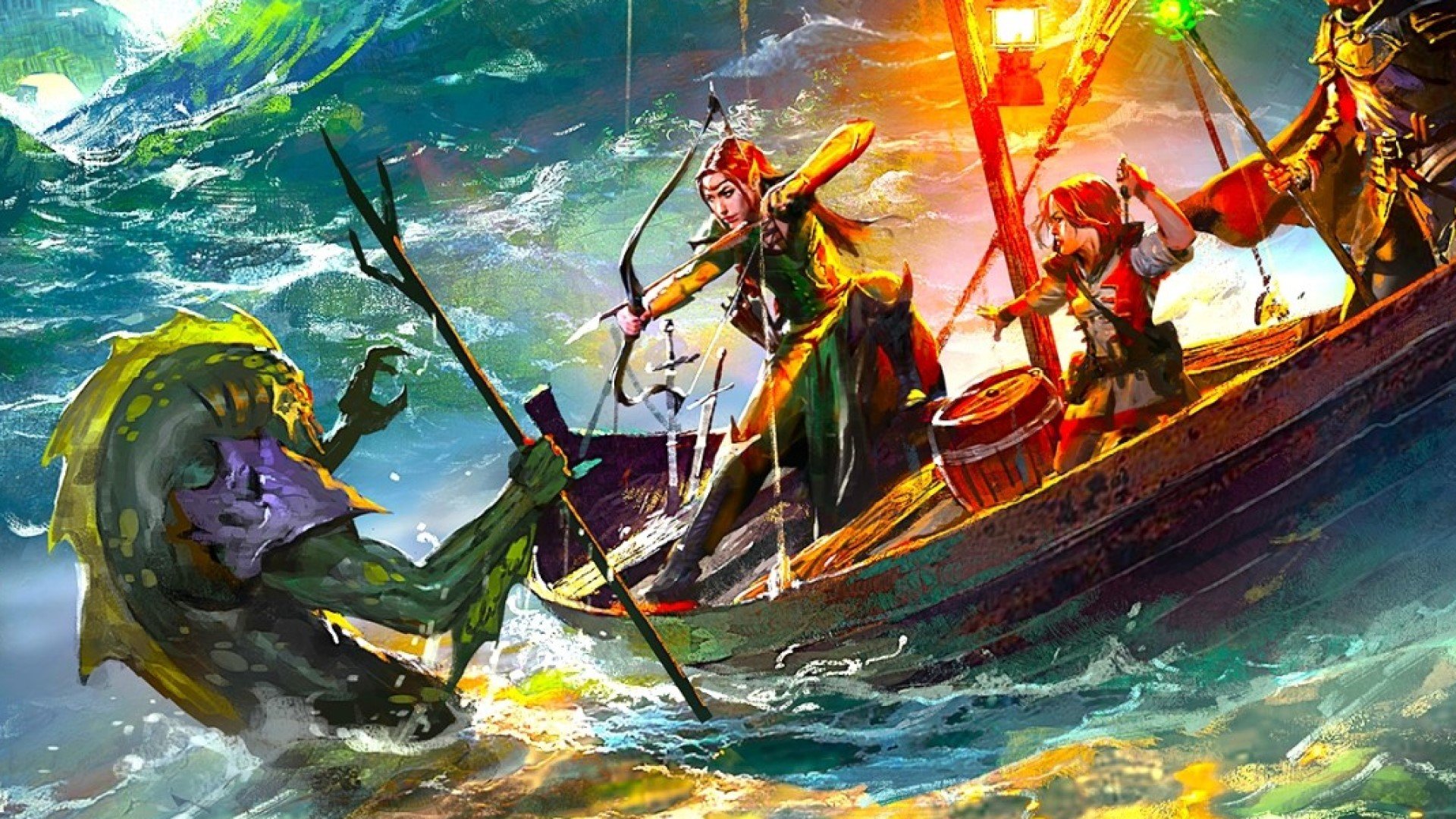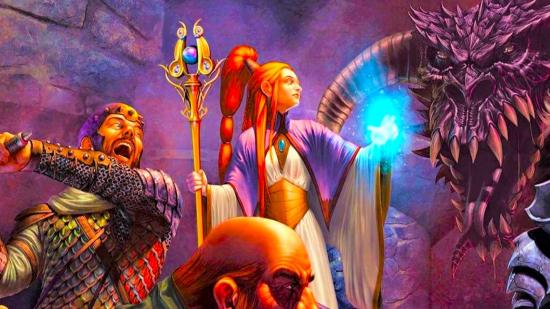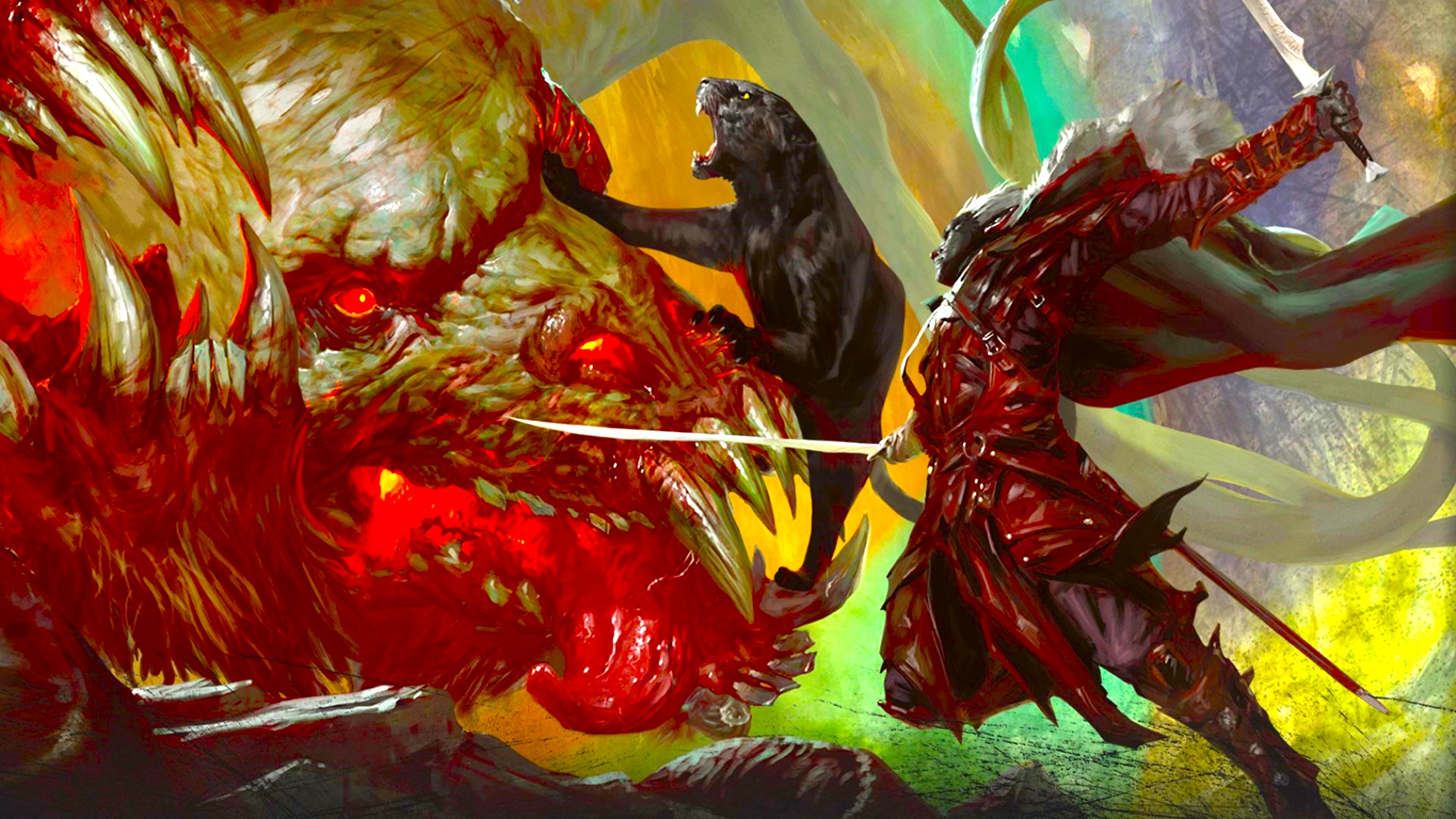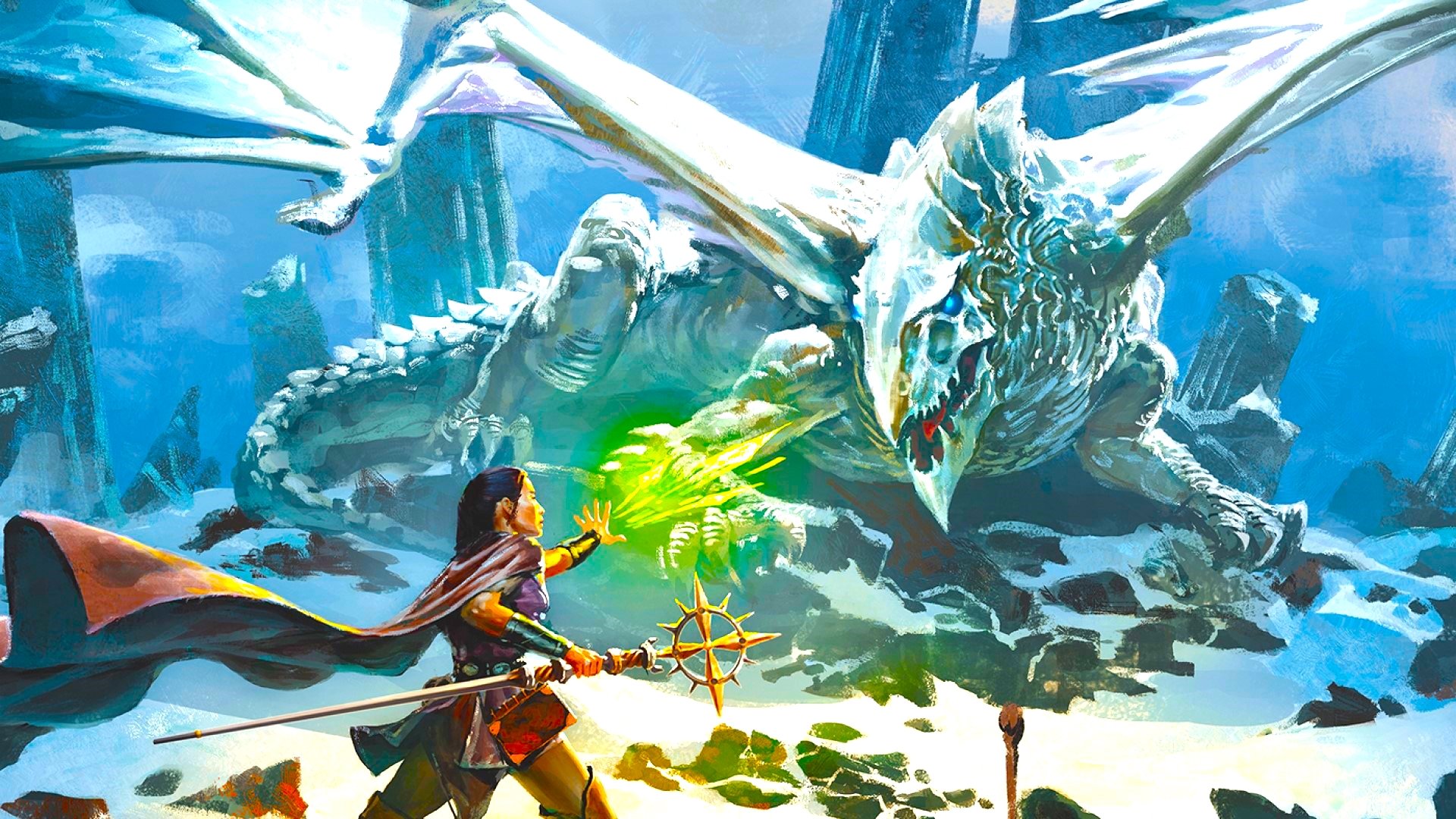Unless you can cast spells, you’ll need one or more DnD weapons to deal damage in combat. This guide explains how Dungeons and Dragons weapons work, and it contains all the key info on basic weapon options. If you need help choosing a 5e weapon, we’ve also included a tier list that separates the serious swords from the silly sticks.
If you want to wield something special, you might find our DnD magic items guide useful. And if you want to check what weapons your character can use, our DnD classes and DnD races guides can remind you.
Here’s everything you need to know about DnD weapons:
- Weapon proficiency
- DnD weapons table
- Weapon properties
- Improvised weapons
- Silvered weapons
- Special weapons
- DnD weapons tier list

Weapon proficiency
Your race, class, and feats can grant you proficiency with certain weapons or categories of weapons. The two categories are simple and martial.
Most people can use simple weapons with proficiency. These weapons include clubs, maces, and other weapons often found in the hands of commoners.
Martial weapons, including swords, axes, and polearms, require more specialized training to use effectively. Most warriors use martial weapons because these weapons put their fighting style and training to best use.
Proficiency with a weapon allows you to add your proficiency bonus to the attack roll for any attack you make with that weapon. If you make an attack roll using a weapon with which you lack proficiency, you do not add your proficiency bonus to the attack roll.

DnD weapons table
The DnD weapons table shows the most common weapons used in the fantasy gaming worlds, their price and weight, the damage they deal when they hit, and any special properties they possess. Every weapon is classified as either melee or ranged. A melee weapon is used to attack a target within five feet of you, whereas a ranged weapon is used to attack a target at a distance.
Simple melee weapons
| Name | Cost | Damage | Weight | Properties |
| Club | 1 SP | 1d4 bludgeoning | 2 lb | Light |
| Dagger | 2 GP | 1d4 piercing | 1 lb | Finesse, light, thrown (range 20/60) |
| Greatclub | 2 SP | 1d8 bludgeoning | 10 lb | Two-handed |
| Handaxe | 5 GP | 1d6 slashing | 2 lb | Light, thrown (range 20/60) |
| Javelin | 5 SP | 1d6 piercing | 2 lb | Thrown (range 30/120) |
| Light hammer | 2 GP | 1d4 bludgeoning | 2 lb | Light, thrown (range 20/60) |
| Mace | 5 GP | 1d6 bludgeoning | 4 lb | – |
| Quarterstaff | 2 SP | 1d6 bludgeoning | 4 lb | Versatile (1d8) |
| Sickle | 1 GP | 1d4 slashing | 2 lb | Light |
| Spear | 1 GP | 1d6 piercing | 3 lb | Thrown (range 20/60), versatile (1d8) |
Simple ranged weapons
| Name | Cost | Damage | Weight | Properties |
| Crossbow, light | 25 GP | 1d8 piercing | 5 lb | Ammunition (range 80/320), loading, two-handed |
| Dart | 5 CP | 1d4 piercing | 1/4 lb | Finesse, thrown (range 20/60) |
| Shortbow | 25 GP | 1d6 piercing | 2 lb | Ammunition (range 80/320), two-handed |
| Sling | 1 SP | 1d4 bludgeoning | – | Ammunition (range 30/120) |
Martial melee weapons
| Name | Cost | Damage | Weight | Properties |
| Battleaxe | 10 GP | 1d8 slashing | 4 lb | Versatile (1d10) |
| Flail | 10 GP | 1d8 bludgeoning | 2 lb | – |
| Glaive | 20 GP | 1d10 slashing | 6 lb | Heavy, reach, two-handed |
| Greataxe | 30 GP | 1d12 slashing | 7 lb | Heavy, two-handed |
| Greatsword | 50 GP | 2d6 slashing | 6 lb | Heavy, two-handed |
| Halberd | 20 GP | 1d10 slashing | 6 lb | Heavy reach, two-handed |
| Lance | 10 GP | 1d12 piercing | 6 lb | Reach, special |
| Longsword | 15 GP | 1d8 slashing | 3 lb | Versatile (1d10) |
| Maul | 10 GP | 2d6 bludgeoning | 10 lb | Heavy, two-handed |
| Morningstar | 15 GP | 1d8 piercing | 4 lb | – |
| Pike | 5 GP | 1d10 piercing | 18 lb | Heavy, reach, two-handed |
| Rapier | 25 GP | 1d8 piercing | 2 lb | Finesse |
| Scimitar | 25 GP | 1d6 slashing | 3 lb | Finesse, light |
| Shortsword | 10 GP | 1d6 piercing | 2 lb | Finesse, light |
| Trident | 5 GP | 1d6 piercing | 4 lb | Thrown (range 20/60), versatile (1d8) |
| War pick | 5 GP | 1d8 piercing | 2 lb | – |
| Warhammer | 15 GP | 1d8 bludgeoning | 2 lb | Versatile (1d10) |
| Whip | 2 GP | 1d4 slashing | 3 lb | Finesse, reach |
Martial ranged weapons
| Name | Cost | Damage | Weight | Properties |
| Blowgun | 10 GP | 1 piercing | 1 lb | Ammunition (range 25/100), loading |
| Crossbow, hand | 75 GP | 1d6 piercing | 3 lb | Ammunition (range 30/210), light, loading |
| Crossbow, heavy | 50 GP | 1d10 piercing | 18 lb | Ammunition (range 100/400), heavy, loading, two-handed |
| Longbow | 50 GP | 1d8 piercing | 2 lb | Ammunition (range 150/600), heavy, two-handed |
| Net | 1 GP | 3 lb | – | Special, thrown (range 5/15) |

Weapon properties
Many weapons have special properties related to their use, as shown in the weapons table.
Ammunition
You can use a weapon that has the ammunition property to make a ranged attack only if you have ammunition to fire from the weapon. Each time you attack with the weapon, you expend one piece of ammunition. Drawing the ammunition from a quiver, case, or other container is part of the attack (you need a free hand to load a one-handed weapon). At the end of the battle, you can recover half your expended ammunition by taking a minute to search the battlefield.
If you use a weapon that has the ammunition property to make a melee attack, you treat the weapon as an improvised weapon (see the section on improvised weapons later on). A sling must be loaded to deal any damage when used in this way.
Finesse
When making an attack with a finesse weapon, you use your choice of your Strength or Dexterity modifier for the attack and damage rolls. You must use the same modifier for both rolls.

Heavy
Small creatures have disadvantage on attack rolls with heavy weapons. A heavy weapon’s size and bulk make it too large for a Small creature to use effectively.
Light
A light weapon is small and easy to handle, making it ideal for using when fighting with two weapons.
Loading
Because of the time required to load this weapon, you can fire only one piece of ammunition from it when you use an action, bonus action, or reaction to fire it, regardless of the number of attacks you can normally make.
Range
A weapon that can be used to make a ranged attack has a range in parentheses after the ammunition or thrown property. The range lists two numbers. The first is the weapon’s normal range in feet, and the second indicates the weapon’s long range. When attacking a target beyond normal range, you have disadvantage on the attack roll. You can’t attack a target beyond the weapon’s long range.
Reach
This weapon adds five feet to your reach when you attack with it, as well as when determining your reach for opportunity attacks with it.

Special
A weapon with the special property has unusual rules governing its use, explained in the weapon’s description (see the special weapons section later on).
Thrown
If a weapon has the thrown property, you can throw the weapon to make a ranged attack. If the weapon is a melee weapon, you use the same ability modifier for that attack roll and damage roll that you would use for a melee attack with the weapon. For example, if you throw a handaxe, you use your Strength, but if you throw a dagger, you can use either your Strength or your Dexterity, since the dagger has the finesse property.
Two-Handed
This weapon requires two hands when you attack with it.
Versatile
This weapon can be used with one or two hands. A damage value in parentheses appears with the property – the damage when the weapon is used with two hands to make a melee attack.

Improvised Weapons
Sometimes characters don’t have their weapons and have to attack with whatever is at hand. An improvised weapon includes any object you can wield in one or two hands, such as broken glass, a table leg, a frying pan, a wagon wheel, or a dead goblin.
Often, an improvised weapon is similar to an actual weapon and can be treated as such. For example, a table leg is akin to a club. At the GM’s option, a character proficient with a weapon can use a similar object as if it were that weapon and use their proficiency bonus.
An object that bears no resemblance to a weapon deals 1d4 damage (the GM assigns a damage type appropriate to the object). If a character uses a ranged weapon to make a melee attack, or throws a melee weapon that does not have the thrown property, it also deals 1d4 damage. An improvised thrown weapon has a normal range of 20 feet and a long rage of 60 feet.
Silvered weapons
Some monsters that have immunity or resistance to non-magical weapons are susceptible to silver weapons, so cautious adventurers invest extra coin to plate their weapons with silver. You can silver a single weapon or ten pieces of ammunition for 100 gold pieces. This cost represents not only the price of the silver, but the time and expertise needed to add silver to the weapon without making it less effective.

Special weapons
Weapons with special rules are described here.
Lance
You have disadvantage when you use a lance to attack a target within five feet of you. Also, a lance requires two hands to wield when you aren’t mounted.
Net
A Large or smaller creature hit by a net is restrained until it is freed. A net has no effect on creatures that are formless, or creatures that are Huge or larger. A creature can use its action to make a DC 10 Strength check, freeing itself or another creature within its reach on a success. Dealing five slashing damage to the net (AC 10) also frees the creature without harming it, ending the effect and destroying the net.
When you use an action, bonus action, or reaction to attack with a net, you can make only one attack regardless of the number of attacks you can normally make.

DnD weapons tier list
S Tier
Dagger 5e
The dagger 5e may have a low damage output, but its multiple properties more than make up for this. You can dual-wield them or throw them, and the finesse property makes this a viable weapon for a broader range of melee builds. We’d mainly recommend these for Dex-based classes like the DnD Rogue.
DnD Greatsword
It’s heavy, and it pairs perfectly with the Great Weapon Fighting feat 5e. Plus, it’s impossible to roll a 1 with 2d6 – the odds are in your favor when it comes to DnD greatsword damage.
Hand crossbow 5e
With excellent range and the light property, the light crossbow 5e is a solid option for characters of all classes and DnD sizes. It suits DnD Rangers and Fighters who want to dominate at a distance, and it’s not a bad backup plan for spellcasters who are out of spell slots. You can even dual-wield them – just be sure to take the Crossbow Expert feat to avoid that pesky loading property.
Light crossbow 5e
If you’re not proficient in martial weapons, the light crossbow 5e makes a decent replacement for the hand crossbow. It takes two hands rather than one, but it still offers excellent range and decent damage for its size and price. Again, Crossbow Expert is a must-have.
Longbow 5e
Longbow 5e is the ranged martial weapon in Dungeons and Dragons. It offers a staggering range compared to its competitors. The only major downside is that it’s heavy, so Small characters are unable to wield it.

Maul 5e
The maul 5e is like a much heavier greatsword, but it deals bludgeoning damage instead. What’s not to love?
Rapier 5e
The rapier 5e may not have many fancy features, but it does more damage than any other finesse weapon. That alone makes it a common staple for Rogues and melee Rangers.
Shortsword 5e
1d6 may seem like a middle-of-the-road damage die, but it makes the shortsword 5e your best option if you’re planning to dual wield weapons. It’s also a solid option for finesse fighters.

A Tier
Battleaxe 5e
The battleaxe 5e is a basic but powerful option for melee martials like the DnD Fighter. The option to choose between 1d8 and 1d10 damage is tasty, and it allows you to be a little flexible with your character build.
Glaive 5e
If you’re planning to take the Polearm Master feat, the glaive 5e is one of the most reliable sources of damage. It is a heavy weapon that requires two hands, though, so your build options are slightly more limited.
Greataxe 5e
It may be heavy and two-handed, but the greataxe 5e has the highest damage die possible for a weapon. As long as your DnD Barbarian is the right size, you should have no problems. Be sure to take Great Weapon Fighting to make it even better.
Halberd 5e
The halberd 5e is exactly the same as the glaive, and works for the exact same reasons.
DnD Handaxe
The DnD handaxe is our thrown weapon of choice when Strength is your main DnD stat. For a weapon that’s thrown and can be dual-wielded, 1d6 damage isn’t too shabby.

Heavy crossbow 5e
Heavy crossbow 5e has the best damage output of all the crossbows, and it has the second-best range of any basic ranged weapon. The heavy and two-handed feature make it slightly less appealing, though – especially if you haven’t taken a feat to deal with its loading property.
Javelin 5e
The javelin 5e is a reliable favorite of ours. Middling damage is enhanced by the weapon’s thrown range, and it offers a surprising amount of versatility to martial fighters.
Longsword 5e
Lighter but more expensive than a battleaxe, the longsword 5e is strong for all of the same reasons. Seriously – same damage die, DnD damage type, and properties.

Quarterstaff 5e
Popular with DnD Druids that love Shillelagh, the quarterstaff 5e is a solid all-rounder. It’s the only versatile simple weapon, and it pairs well with the Polearm Master feat.
Shortbow 5e
If you can’t wield a longbow, the simple shortbow 5e is your next best bet. Decent damage and good range, but you’ll need two hands.
Spear 5e
The spear 5e doesn’t have a particularly impressive range, but its versatile property helps make it an incredibly flexible weapon.
Warhammer 5e
The warhammer 5e is a longsword that deals bludgeoning damage. Strong, but not mind-blowing.

B Tier
Light Hammer 5e
The light hammer 5e is a dagger without its finesse property. And that means it’s just a worse version of the handaxe.
Scimitar 5e
The scimitar 5e has all the same features as a shortsword, but it’s heavier and significantly more expensive. If we’re planning a dual-wielding build, we’ll pick the shortsword instead.
War pick 5e
With no special properties at all, the war pick 5e is the definition of ‘pretty good’. 1d8 piercing damage is a sensible (but not spectacular) option.
Flail 5e
It’s the same situation with the flail 5e. A decent damage die and access to bludgeoning damage, but nothing remarkable to comment upon.

C Tier
Dart 5e
The dart 5e is exclusively a ranged weapon, unlike other options with the thrown property. This has upsides as well as downsides, such as being able to use your Dexterity modifier for a ranged attack, but we’d prefer a thrown weapon we can still use in melee.
Lance 5e
1d12 damage is excellent, but the lance 5e rarely seems worth it thanks to its special rules. A greataxe can deal just as much damage, but if you’re married to the idea of dealing piercing damage (and riding a mount), this might still be the weapon for you.
Pike 5e
The pike 5e is a powerful reach weapon, but we prefer the Halberd and the Glaive. This is mainly because of the Polearm Master feat – for some reason, only half of the feat’s benefits apply to a pike. If you’re not taking this feat and you want to specialize in piercing damage, this is still a solid option.
Sickle 5e
The sickle 5e’s low damage output and lack of interesting properties make it one of the worse options for dual-wielding.
Sling 5e
As far as ranged weapons go, we don’t rate the sling 5e. The option to deal bludgeoning damage from a distance is nice, but there’s just not enough power on offer.
Whip 5e
The whip 5e seems like a no-brainer for Indiana Jones style builds, but the damage output just isn’t that impressive. Flavor is doing a lot of the heavy lifting here.

D Tier
Blowgun 5e
One piercing damage, plus all the most cumbersome weapon properties? We’re not really sure who the blowgun 5e is for.
DnD Club
The only notable thing about the DnD club is its price. It’s the cheapest weapon you can buy, and you get what you pay for.
Greatclub 5e
The greatclub 5e is heavy and unwieldy, with its properties causing more problems than they solve. The 1d8 damage isn’t really worth it.
Mace 5e
Middling damage and no special properties make the mace 5e particularly unimpressive.
Morningstar 5e
The morningstar 5e is the same as a war pick, but it’s three times the price and double the weight.

Net 5e
The net 5e is highly situational, but if you can make use of it, it’s a fun bit of area control. We’d never choose it over a weapon that deals damage, though.
Trident 5e
The trident 5e is versatile, but its damage is less impressive than other versatile options. Plus, in all other areas, it’s just a javelin that costs significantly more money.
Need more gear? Here’s everything you need to know about DnD armor. Or, if you’d prefer to take out baddies in a different way, here’s a comprehensive guide to DnD spells.
This guide directly presents rules text for DnD weapons, published by Wizards of the Coast under a Creative Commons Attribution 4.0 license.
